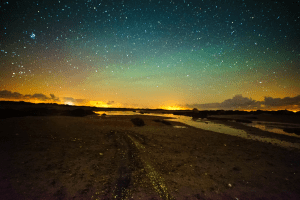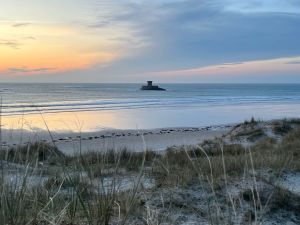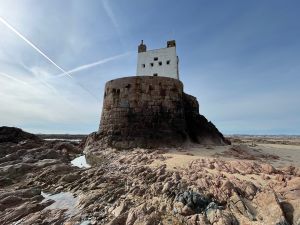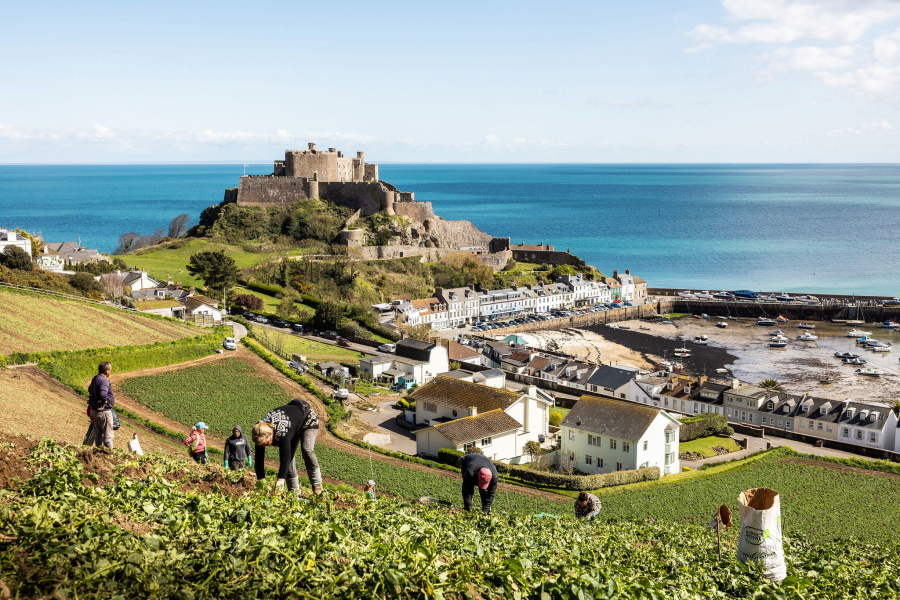Simon Di Meo dons his wellies to explore Jersey and its intertidal wilderness, unearthing an otherworldly coastal experience.
If an unplugged coastal adventure is your thing but following campervans on the Cornish A30 is not, Jersey might just offer the perfect solution. After endless days glued to my computer screen, I was relishing a device-free weekend exploring Jersey’s wilder side.
A 40-minute hop from the major UK airports, my 6pm Friday flight from Gatwick had me at my sea view 7.30pm dinner reservation at Corbière Phare with time to spare – nothing is more than 20 minutes away in Jersey.
Mesmerised by the view – even more spectacular from the viewing deck of my accommodation at nearby Corbière Radio Tower – it was clear that alongside the island’s visual splendour is a palpable sense that Jersey feels just a little different.
Tucked into the Bay of St Malo on the French side of the English Channel, Jersey has remained fully independent of Westminster and France. Local curiosities abound, for example, road and place names derive from the local Norman dialect Jèrriais. Familiar but ‘Brit(ish)’, as a local tourism campaign cleverly asserts.
Whilst Jersey’s jaw-dropping beaches and beautiful coastal trails are still very much a year-round draw, it is lesser known that at more than 40 feet, the island has the third largest tidal movement in the world. Its land mass swells by a third at low tide to uncover an extensive intertidal landscape ripe for exploration.
My first adventure was straight after dinner; a nighttime bioluminescence tour within the protected UNESCO Ramsar area to the south east of the island – the largest rocky intertidal zone in Europe. Bioluminescence is the emission of light by living organisms, in this case millions of tiny worms or bioculata, that dwell just under the surface of the sand.

My guides were the highly knowledgeable Trudie and Derek of Jersey Walk Adventures (jerseywalkadventures.co.uk/). Derek explained the rare confluence of circumstances required to witness this spectacular nocturnal light show; a new moon, little or no external light pollution, a low tide and good visibility.
Against the backdrop of the magnificent medieval Mont Orgueil Castle and the lights of Carteret and Port-Bail on the nearby French coast, Derek pointed out the unobscured constellations of stars overhead. As we set out into the penumbra of the tidal gullies, there was a tangible sense of expedition within the group.
Using UV lights to illuminate seaweeds and anemones in spectacular technicolour, our guides led us to a prime spot. Simply dragging the bottom of a wellington boot across the sand uncovered thousands of the tiny worms in question to reveal highways of stardust in the pitch black. Splashing through the shallow pools of water produced a further spray of neon light, like sparks from a metal saw.
So vivid was the show that I was certain I had fallen prey to a local ruse. Derek, however, reassured me: “How we look at the world depends on what we take the time to see. Most people don’t realise this is out here just a few hundred yards from shore. We use darkness and in return see an incredible amount.” I headed to bed feeling like I’d witnessed another realm, where the relative merits of city living were brought into stark question.
Early Saturday morning I had the privilege of a private guided tour with much sought-after local forager Kazz Padidar of Wild Adventures (wildadventuresjersey.com/), this time in the wild and beautiful St Ouen’s Bay along the island’s western Atlantic extremity.

We began our tour just above St Ouen’s five sandy miles to forage the shoreline vegetation. What looked to me like a collection of random weeds and grasses turned out to be an abundant natural larder for the cognoscenti like Kazz. “You could eat off the land and sea in Jersey, it’s so rich,” he asserts with a grin to challenge my expression of mild scepticism.
Every second step Kazz would hand me a leaf, stalk or fungus, each delivering vivid flavours. “Check out this wood sorel for a sharpness and try this salty sea spinach,” he’d say. “Sand wort tastes of cucumber – the gin makers are into it.” Now there’s an incentive for further research…
Foraging, however, is not for the uninitiated. After sampling peppery sea radish, Kazz holds up a seemingly identical leaf growing adjacent to it. “See this? Ragwort, very poisonous! Watch out for these destroying angel mushrooms too. It’ll take a week but they’ll kill you!” Duly noted.
As we progress onto the beach, the flavour bounty transforms once again. “Kelp has a natural MSG that enhances food flavour with a double membrane that opens up like a pocket that you can steam fish in,” says Kazz.
We pass another clump of weed clinging to a rock, “You’ll get truffle vibes from this pepper dulce.” “No chance,” I thought – I thought wrong – as the unmistakably intense truffle aroma engulfed my senses. “This goes for a hundred quid a kilo,” exclaims Kazz, who is has a backlog of orders from Britain’s top restaurants eager to leverage his foraging skills.
Our tour culminates out in the tidal pools for a spot of ‘rock rolling’ to reveal local ormers, chancre crabs, lobsters and flat fish. Each find was accompanied by a recipe suggestion from Kazz’s extraordinary trove of culinary knowledge that was making me hungry.
Trudie was again on hand to host my Sunday walk to Seymour Tower, beginning at the quaint Seymour Pub with a dozen Jersey rock oysters from the adjacent Bay of Grouville. “Oysters have a ‘merrior’, like terroir in wine parlance. The granite bedrock and local seaweed give them their distinct flavour,” she elaborates.

As we chase the rapidly receding tide, Trudie begins to decode the pristine marine environment in expert detail. “Bladderwrack has bubbles containing SPF 15 jelly that can also be used in the bath or even to add creaminess to a soup. Egg wrack has a flavour much like capers and serrated wrack can be made into crisps.”
She next gives a flavour of the geological history of the area. “During the Ice Age Jersey was connected to France and mammoths and woolly rhinos were hunted by Stone Age people in the area. There also appear to be remnants of pagan worship sites marked by standing stones hauled into position from other areas of the island,” she adds.
Almost two miles off the east coast of Jersey, Seymour Tower was commissioned in 1782 as a defence outpost following the Battle of Jersey when French forces staged a stealth attack and almost took control of the island. Today it is available for rustic overnight stays for up to seven, accompanied by a guide. Trudie beckons me inside what is essentially a well-equipped mountain hut, much to the envy of some passing ramblers.
“You can fish from the panoramic parapet for bass and rake the surrounding sands for fresh clams for dinner,” she asserts. “As the tide cuts you off from the mainland you become master of your own feudal fortress – what could be better?” As I unpack my sleeping bag to bed down for the evening with just the sunset and ocean swell for company, I can’t help but concur.
On my morning hop back across to Gatwick, I wonder why Jersey has flown under the radar as the perfect place to unwind and unplug – especially for those who are time-strapped. Its intertidal wilderness has left me not only feeling replenished but, as all valuable experiences do, also challenged to make changes to my everyday routine. With so much more to explore on and around the island, I’ll certainly be back.
QUIRKY STAYS
Jersey has an ever-increasing offering of more out of the ordinary places to lay your head.
The National Trust of Jersey provides some intriguing options, including converted officer’s quarters, a beautifully renovated Jersey farmstead, a chapel and a vintage bakehouse. nationaltrust.je/
Jersey Heritage offers a former German Bauhaus observation tower soaring above the majestic La Corbiere lighthouse, to a medieval fortress with spectacular sea views of the island’s north coast. jerseyheritage.org/stay/heritage-lets
A debutante to the quirky stable is the newly refurbished Conway Tower; a late 18th century fortification right on stunning St Brelade’s Bay. freedomholidays.com/Property/View/909
FRESH AND SEASONAL EATING
Jersey dining options range from high-end establishments such as the Ocean Restaurant at the Atlantic Hotel (theatlantichotel.com/dining/ocean-restaurant-in-jersey/), to the beloved Jersey Chancre crab sandwich from the Hungry Man kiosk at Rozel Pier.
Sumas delivers not only excellent food but the perfect vantage point over medieval Gorey Castle and harbour (sumasrestaurant.com/) or try more rustic fresh seafood from Faulkner Fisheries (faulknerfisheries.com/)
For dining with a view of the breakers try El Tico on St Ouen’s Bay (elticojersey.com/) or grab a window table at Corbiere Phare to take in a glorious sunset. (corbierephare.com/)
For self-catering, Jade S Fisheries offer up their daily catch from pop-up stalls around the island. (jadesfisheries.com/) whilst Beresford Fish and Central markets showcase the best of island produce in the centre of St Helier.








